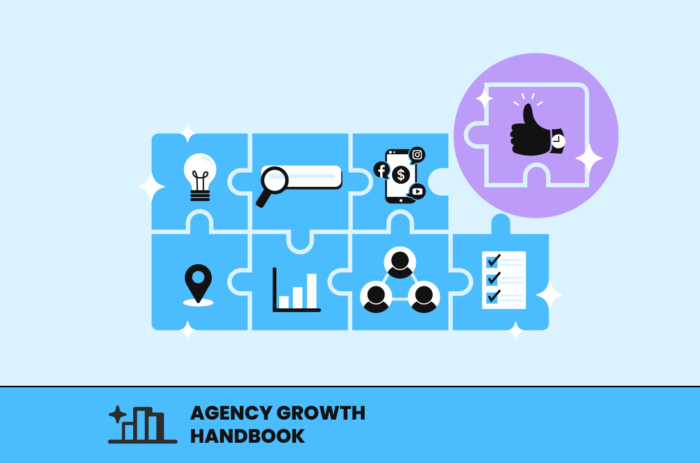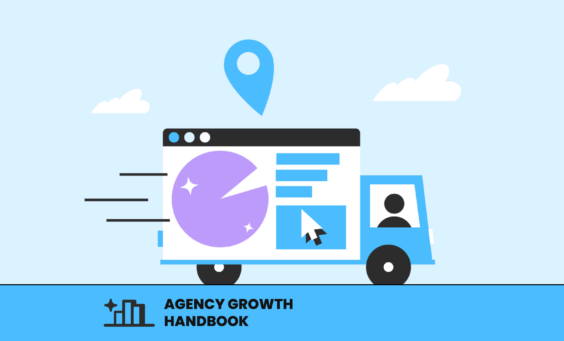This article is from our Agency Growth Handbook—a collection of guides created to help local SEO agencies grow and succeed. It is chapter three of ‘Part Two: Processes and Workflows’.
Building a successful SEO agency requires a laundry list of moving parts to come together. You need a skilled, knowledgeable, and engaged team with a variety of skillsets. For starters, you need negotiation and networking skills to bring on new clients and then ensure they stick around. Then you need teams who are capable of actually doing the work, whether that’s local SEO, digital PR, paid media, or whatever other service you’re offering. A clear USP is non-negotiable to stand out from the crowd.
Before any of that, you need to choose the right structure to knit it all together.
How you organize and run your agency is fundamental. This alone determines how efficiently and effectively you execute client projects. It directly impacts your ability to scale your business, how your team members operate, and how they collaborate. It goes without saying that it will also have a huge impact on your SEO agency’s profitability.
The challenge is that there are multiple potential agency structures you could choose. Deciding which is right for you will be influenced by factors such as your own experiences as an employee, the clients you have, the existing skillset at your agency, your company culture, and your longer-term business goals.
Do you want your agency to have multiple offices in other states, for example? If so, you need a structure that can easily replicate in secondary locations. Or do you want to become the go-to choice for local businesses in your city? Do you have a strong content offering but only one person doing PR? How does each of these affect your setup?
If you’ve previously worked at agencies with little accountability or felt stressed and burnt out by competing responsibilities, you might crave a more traditional structure. On the flip side, a pod setup could give you what you need if you thrive in highly collaborative, client-focused environments.
There’s a lot to think about, so let’s dive in.
4 Marketing Agency Structures
Before we go much further, it’s worth defining the structures we’ll refer to throughout this article. For the sake of this article, we are referring to four different structures: traditional/hierarchical, pods/squads, matrix, and freelance.
Getting your marketing agency structure right sets the best possible foundation for your future growth. Deciding precisely how your teams will be organized and how your chain of command will operate can be daunting because so much rides on getting it right.
| Agency Structure Type | Structure Overview |
|---|---|
| Traditional or Hierarchical | A pyramid-type structure with a top-down chain of command and clearly defined roles and responsibilities. You or your board sits at the tip of the pyramid. The c-suite occupies the second tie, and below them sit the heads of each department. You’ll then staff your departments with people who specialize in that field. |
| Pods or Squads | Your marketing experts are grouped into small pods or squads. Each pod operates as a self-contained unit within the agency and is assigned to a specific account or project. |
| Matrix | A matrix structure borrows from both the traditional and pod models. Your agency follows a traditional structure in that you have defined departments, clear department heads, and hierarchical management. Multi-disciplinary, cross-department teams are then created and assigned to specific client projects. |
| Freelance | Your agency operates with few to no direct hires but brings in freelancers and subcontractors on an ‘as needed’ basis, usually below the manager level. |
Other structures are available, but they often overlap with the ones mentioned above or at least heavily rely on them.
Why it’s Important to Structure Your Agency the Right Way
There are tens of thousands of SEO agencies across the United States specializing in traditional SEO, local SEO, or a blend of the two. No matter where you’re based, you’re unlikely to be the only option in town. That means you’ll be competing to secure a limited pool of clients. Whether you’ve developed a super-efficient content process or have identified an untapped niche, every edge you can get over others matters.
Your SEO team structure allows you to leverage those opportunities for maximum impact. It determines how optimized your organization is and influences every action that takes place within your agency every day. Get it right, and you’re set up for success. If you get it wrong, you will likely find scaling your agency an uphill battle.
Team Morale
Because your agency structure defines how your teams work, its impact on morale can’t be overstated. An optimal team structure gives everyone a clear idea of their responsibilities and who they report to. The right organizational structure will nurture individual creativity, encourage accountability, and enhance collaboration. Each of these factors helps to keep employees engaged, motivated, and committed to delivering successful client projects.
Employee Retention
Team morale is a critical factor in employee retention—a vital consideration for any local SEO agency. Maintaining the same team ensures consistency within your client relationships. Perhaps most importantly, it also keeps the knowledge you’ve developed through training and mentorship within your business rather than walking out the door to benefit a rival agency.
Current estimates place the cost of recruiting a new staff member at $4,000 – $20,000 (excluding salary and benefits). So, keeping your existing team happy is much easier on your bottom line than trying to find new people to fit into a structure that simply isn’t working.
Optimal Resource Management
The right team structure enables you to optimize how your resources are managed and deployed. Regardless of headcount, the correct structure will empower you to easily assign tasks and organize workflows in a way that makes the best use of each person and their unique skill sets.
Collaboration and Communication
When hierarchies and relationships between individual roles are well established, collaboration and communication can thrive. Establishing those channels benefits every aspect of agency operations, from creativity and productivity to efficiency and effectiveness.
Faster Decision-making
Things happen quickly in the local SEO space, so you can’t afford for your agency’s decision-making process to be slow and cumbersome. A clear, well-defined SEO team structure allows the right people to make fast decisions when called for. This can positively impact how your agency responds to client needs or changing market conditions.
The Ability to Scale
Think about some of the tasks you routinely conduct during a typical local SEO project. Perhaps that’s performing keyword research or sending out ranking reports to clients. You can complete those tasks quickly and for any number of clients because you have a workflow that you can scale.
Having the right marketing agency structure follows the same principle. If it’s designed and implemented correctly, you can duplicate that structure to bolt on additional teams or offices as your business grows.
Is there such a thing as a perfect agency structure?
Working in SEO, you know the answer to this already… “it depends.”
As an SEO professional, you’re programmed to sniff out the best and most efficient way to do something. That’s what drives improved search visibility for your clients. So, when thinking about how to structure a digital marketing agency, you’re most likely looking for the optimal way to position and connect departments, teams, and roles.
If this puzzle is already giving you sleepless nights, you can rest easy. While some setups will be more suited to how you prefer to work than others, there’s no one perfect answer.
The optimal pathway for you depends on your company culture, the work you do, your clients, the size of your business, its specialisms, and your growth ambitions. Every organizational model will come with pros and cons.
If you’re a larger, multi-disciplinary agency, you may naturally have defined teams like SEO, content, and paid search already in place and grouped according to area of expertise. In this scenario, a traditional or functional set-up may suit you best, with teams defined by their function and more experienced or senior people taking on additional responsibility by assuming management roles.
On the other end of the spectrum, if you’re building a remote agency that operates as leanly as possible and doesn’t have full-time direct hires, a freelance model could give you the cost savings and agility your business model needs.
It may seem inconsequential, but even your client reporting and communication style can influence which agency structure is better suited to your business. Are your clients handled by a dedicated client services team, or is it the case that each person deals with specific clients? Do team members provide reports and progress updates as they perform keyword research, optimize Google Business profiles, or build citations?
There’s no universally correct answer. You’ll undoubtedly have to compromise in some areas to benefit in others. The secret to success lies in choosing the structure that gives you, specifically, more pluses in the ‘pro’ column than negatives in the ‘con’ list.
Where does local SEO sit?
For the last 10 years, Google data has suggested that four in five searches have a local intent. Ask any marketing professional, and that translates to one thing—an enormous opportunity to tap into a growing and lucrative market: local search optimization.
Where local SEO sits within your wider agency business is a crucial consideration when deciding how best to structure for scalability and growth.
Some agencies may have a dedicated local SEO team, but others may divide the tasks into different roles. Perhaps a social media executive picks up GBP management, a PR reaches out to local publications or businesses about collaborations and links, and an SEO manager oversees the project, and so on.
Questions to ask yourself include:
Is local SEO your core focus, or is it one service offering within a larger agency?
If you only offer a few local SEO services, a pod set-up is ideal for running results-focused campaigns, while a freelance structure provides agility. If you have other divisions for services, such as paid search and content marketing, there are more people and more moving parts to consider. In that scenario, the traditional hierarchical structure is a popular choice.
Do you have groups of experts (copywriting, social media, technical SEO) who work across all client projects?
A flat or matrix structure allows for a higher degree of collaboration, which could bring enhanced creativity and innovation to your client projects.
Do you have smaller multi-disciplinary groups who tend to handle specific client accounts autonomously?
Organizing teams into pods means your crew can develop a deep understanding of their specific client accounts. This tends to lead to strong client relationships, high retention rates, and excellent case studies.
Would the account management process need to change if you were to take on new clients?
If your local agency suddenly receives an influx of new clients, it’s vital that your existing clients don’t notice an abrupt decline in service levels. You’ll need to be able to replicate the same processes at scale. That’s achievable if you can create new pods or hire new SEO experts to join an existing team.
How Each Structure Works in Practice
Traditional or Hierarchical
It’s common to see the traditional or hierarchical agency structure in place in large businesses with multiple departments.
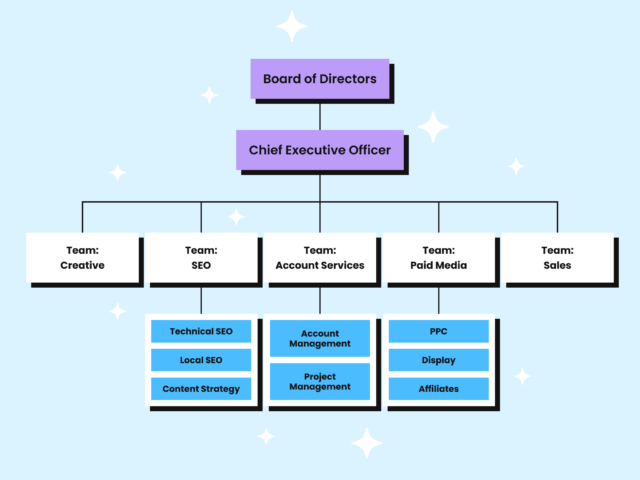
How the Traditional Model Works
Your agency is organized into individual divisions or departments, typically by function. Everyone reports to a higher-up, with team leaders, department heads, vice presidents, the CEO, and the board of directors filling out the chain of command.
This type of structure is found in pretty much every industry. Some of your clients may operate in this way, especially the larger multi-location businesses that retain your local SEO services.
Pros
You will likely feel very familiar with this traditional marketing agency structure. Given its continued popularity across every sector of the economy, this organizational model has well-established advantages.
- Easy to scale: Scalability is the number one reason that you might be tempted to go with this traditional marketing agency structure. Because there’s a clear chain of command and clearly defined divisions, it’s easy to scale up as your business grows. If your sales team reaches its target and brings in a large volume of new business, you can easily hire more people into your existing departments. If you want to expand your service offering, you can slot in a new division.
- Accountability: Another significant advantage, especially if you expect to have a large headcount, is that everyone knows exactly what their role is, what their responsibilities are, and who they report to. There’s no ambiguity about who does what, so everyone can be held accountable.
- Scope for career progression: The traditional model usually provides a defined pathway for anyone wishing to work their way up the career ladder. For example, someone joining your team as a junior local SEO exec could progress to a senior specialist, team leader, department head, or VP as they grow their skills and experience.
- Development of expertise: As your team members will sit within a specific division, there’s plenty of potential to develop expertise in that niche. This depth of knowledge could elevate your client results, giving you an edge in your local area.
- Efficient resource management: The structure and definition of this agency model removes any ambiguity and uncertainty. There’s no question as to who does what. This means you can plan projects efficiently and effectively and optimize resource management.
Cons
There are a few potential downsides with this model, too:
- Bureaucracy: Because of the layers of management, there’s a danger of bureaucracy setting in. This slows down the decision-making process. Having to push change through the chain of command hampers your ability to respond quickly to changing client needs and industry developments.
- A danger of silos: Having distinct divisions can encourage a siloed mentality to creep in, with each division then focusing inwards rather than taking a big-picture approach to agency success. It also means there’s less impetus to collaborate cross-team to get the best solution.
- Conflicting priorities: Leaving each team to manage its resources could affect how well certain projects or clients are prioritized. Rather than client-focused, in some situations your teams may end up focusing on their own budgets and KPIs.
- Communication and ownership confusion: A traditional structure often makes it unclear who works on what accounts or who owns what, especially as there is often not a set group for specific clients.
Pods or Squads
Dividing your agency into pods or squads is another organizational structure to consider as you prime your local SEO agency for growth.
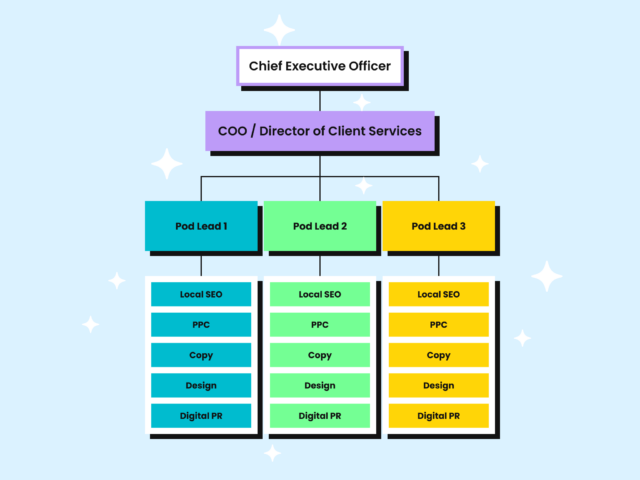
How the Pod Model Works
This organizational chart may look like the traditional structure, but it works differently. You’ll still have a clear chain of command, with a CEO and director at the most senior two levels. Instead of VPs, you’ll have pod leads, and instead of divisions, you’ll have pods.
Each pod is a small, multidisciplinary team comprising a handful of specialists—for example, a Google Business Profile expert, a copywriter, and a PR specialist. Each pod is assigned to a specific client or project, so the makeup of the talent within the pod may differ from one project to another, depending on the project’s requirements.
Pros
- Development of expertise: This type of organizational structure takes a client-first approach. It’s helpful for building sector and client-specific expertise, as each pod will focus on a minimal number of projects. That knowledge can translate into better results for the client.
- Greater client satisfaction: Having a dedicated team focused on their success leads to greater client satisfaction and lower client churn.
- Collaborative and creative: A small group of people dedicated to a project should ensure high levels of collaboration, as everyone is working towards the same objectives. Bringing different skills together also introduces a range of perspectives, which can lead to innovative and creative strategies and problem-solving.
- Greater efficiency: Each pod is a self-contained unit, so it operates more efficiently with fewer roadblocks. This can make your agency more productive, giving you a competitive edge.
- Clear ownership: With each pod having a defined set of clients, it’s very easy to know who to talk to about what for each one.
Cons
- It’s not as easy to scale: Scaling with squads is more challenging than you might think. New hires will need to be onboarded into what could be a close-knit team, which can be a difficult balancing act to juggle. If your client numbers spike, it can be hard to create new pods from existing resources without diluting their focus.
- Lack of agency-wide cohesion: Having independent teams is great for productivity, but it might not be such good news for your overall agency cohesion. With team members working in tight-knit groups on their own projects, it’s easy for siloes to develop, with little unity outside of pods.
- Lack of oversight: Management and decision-making take place within the pod, which makes traditional oversight more challenging. It may be harder to keep abreast of progress and you might be slower to learn of any problems within the squad or emerging trends.
Matrix
Still not sure how to structure your teams? The Matrix model could work if you often have multiple projects requiring input from different departments within the business.
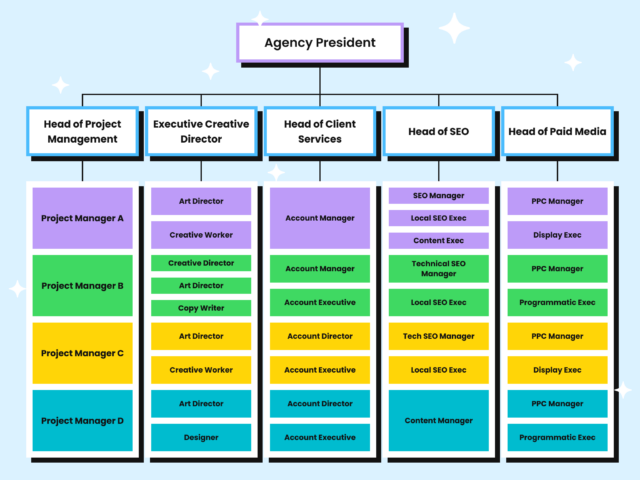
How the Matrix Model Works
The matrix model incorporates aspects of traditional and agency pod structures. Your agency has distinct divisions and a clear management hierarchy, with pods to execute client projects. Each pod is made up of specialists cherry-picked from different divisions in accordance with project requirements.
Pros
- Increased agility: The matrix model gives you the best of both worlds in theory. While there’s the command structure typical of the traditional model, there’s also the flexibility of a squad setup. You can quickly create bespoke multi-disciplinary teams to fit exact project briefs as they come in. The pod can be adjusted by swapping out division specialists as needs change.
- Greater collaboration: There’s a high degree of collaboration between the different divisions involved in each pod. Diverse voices and perspectives can also boost creativity.
- Suited to complex projects: If your client projects are large or complex, the ability to design a custom team of experts to fit the brief is highly beneficial. This also leads to optimal resource use.
- Clear ownership: As with the pod system, you have clear overviews of who to talk to about a specific client and their specialism.
Cons
The matrix model isn’t without its challenges.
- It can introduce complexity: Managing a matrix business can be challenging. That’s because it’s inherently complex, with divisions and pods to oversee. With team members working across both layers—and sometimes reporting to multiple people—measuring productivity and maintaining efficiency becomes more difficult.
- A lack of clarity: One of the main issues with a matrix system is a lack of clarity around who’s responsible for what. There’s a real danger of division heads and pod leaders stepping on each other’s toes, as it won’t always be clear where decision-making responsibility lies.
- Team morale: With team members reporting to more than one boss, they may feel like they’re constantly being pulled in two different directions, especially if you offer more than local SEO services. This can lead to paralysis as they struggle to understand what takes priority and impact morale.
Freelance
Using freelancers and sub-contractors is another way to create a local SEO agency primed for growth.
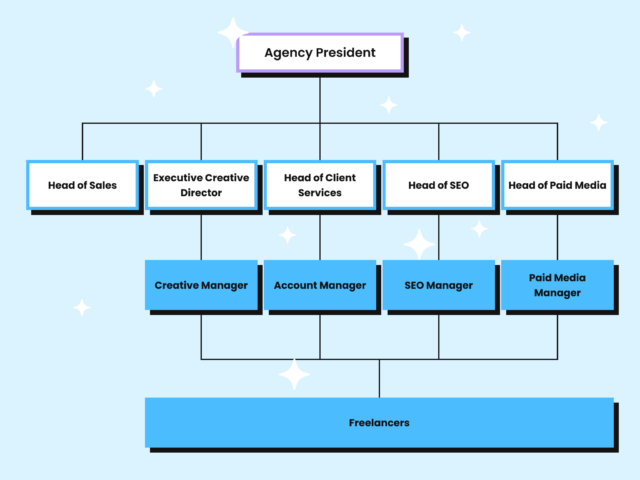
How the Freelance Model Works
While traditional, squad, and matrix structures are popular, they’re often not practical for smaller agencies. Freelance agency models are increasingly popular because they release you from the financial obligations associated with an in-house team but still allow you to complete client projects.
If you win a new local SEO client, you can tap into the freelancer marketplace or sub-contract to independent specialists and then move on when the project ends.
Pros
- Lower overheads: The biggest lure of the freelancer model is lower overheads. You won’t have the financial burden of a full-time team and will only pay for extra pairs of hands when you need them.
- Agility: Provided you already have a vetted pool of talent, the ability to bring on specialists as needed means your business can be very agile. You won’t have to deal with lengthy and expensive recruitment campaigns, nor will you face financial penalties if you no longer need a particular employee.
- A greater pool of talent: A very positive mark in favor of the freelance model is you can access a much wider pool of talent. You aren’t limited to hiring people within traveling distance of your office. Because you aren’t paying a full-time salary, this model may also mean that you can afford to hire more experienced specialists for a shorter period for enhanced client outcomes.
Cons
- A lack of continuity: It’s not a given that you’ll be able to hire the same freelancer or contractor every time, especially if they’re already working with other clients. Continuity could be a problem. It can be time-consuming to have to brief new freelancers on your clients and processes, and the quality of work will vary. This lack of continuity means that your clients might not have the same experience or receive the same level of service each month.
- Varying levels of accountability: Because your freelancer knows they’re only a short-term hire, you might find they aren’t as committed to your project as you may like. Missed deadlines or a sub-standard quality of work aren’t just frustrating; they could also place your client contracts in jeopardy and impact your reputation.
How can tools and services help?
Dedicated services or local SEO tools for agencies can be leveraged to help fill any gaps, regardless of your structure.
Many of the tasks associated with local SEO are time-consuming and repetitive. You can free up your human assets to focus on other client needs by giving them a helping hand with the right tool. Or, potentially, use them to deliver services that you currently don’t have in-house without using freelancers.
BrightLocal’s Citation Builder automates the process of building and managing local citations, for instance, saving hours of time that would otherwise be wasted on tedious tasks such as manually submitting listings or checking for duplication.
Similarly, tools like Google Business Profile Audit save time on tasks such as competitor research and quickly arm your local SEO team with the insights they need to build a winning local search strategy.
Having tools to assist with recurring tasks such as keyword research, rank tracking, and client reporting is a smart way to optimize your workflows and make smarter use of your in-house experts. These beneficial resources contribute to the smooth operation of your business, making it much easier to scale.
